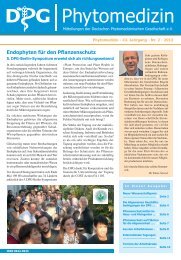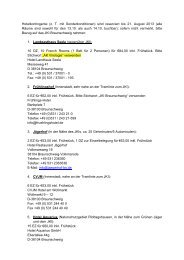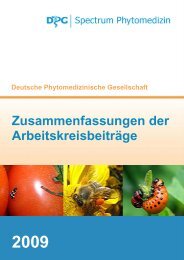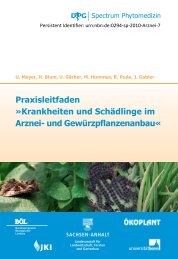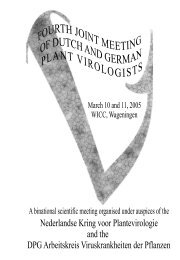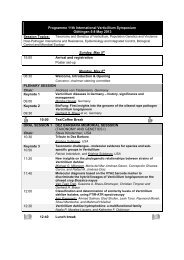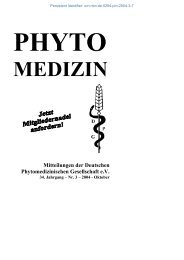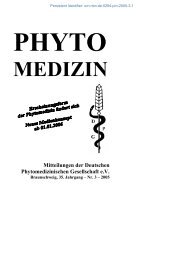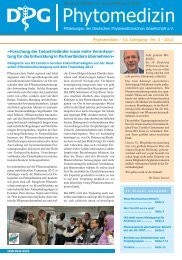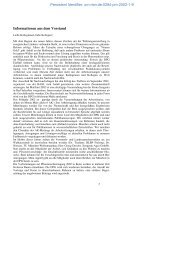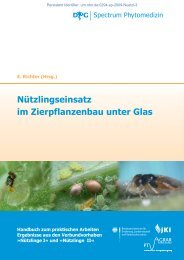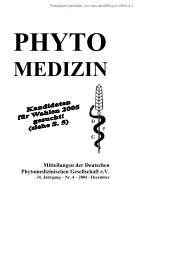- Seite 1 und 2: Deutsche Phytomedizinische Gesellsc
- Seite 3 und 4: INHALT DPG Symposium Plant Protecti
- Seite 5 und 6: Knowledge on real rotations is limi
- Seite 7 und 8: the branches within the voivodeship
- Seite 9 und 10: Announcements of the DPG © Eugen U
- Seite 11 und 12: 88 : 1976 followed by a patent for
- Seite 13 und 14: AK MYKOLOGIE, 24.03.2011 EINFLUSS D
- Seite 15 und 16: identification of novel effector pr
- Seite 17: The green fluorescent protein (GFP)
- Seite 21 und 22: Many plant species rely on the inte
- Seite 23 und 24: in high quantities but also to main
- Seite 25 und 26: des Kohlenstoffflusses über den Wu
- Seite 27 und 28: directive 2000/29/EC and 2007/33/EC
- Seite 29 und 30: Demgegenüber führte das Roden der
- Seite 31 und 32: INFLUENCE OF TEMPERATURE ON THE POP
- Seite 33 und 34: verglichen. Im Vergleich der drei M
- Seite 35 und 36: 8) Einfluss der Temperatur auf die
- Seite 37 und 38: Announcements of the DPG © Eugen U
- Seite 39 und 40: 144 XXX: XXX to mitigate yield loss
- Seite 41 und 42: 146 XXX: XXX Development of a simpl
- Seite 43 und 44: colleagues who took over the task o
- Seite 45 und 46: 60% were obtained for CpGV isolate
- Seite 47 und 48: ESTABLISHMENT OF BEAUVERIA BASSIANA
- Seite 49 und 50: H. hebetor German-strain was 6.7 da
- Seite 51 und 52: female scale underneath the scale c
- Seite 53 und 54: elevated (T6) temperatures over mul
- Seite 55 und 56: Zusammenfassung des Vortragsteils D
- Seite 57 und 58: Nur wenn die Spritzenreinigung einf
- Seite 59 und 60: Eine ausführliche Projektdokumenta
- Seite 61 und 62: Aufgrund der Komplexität des Anlag
- Seite 63 und 64: INHIBITORS FOR AND FROM ERWINIAS (I
- Seite 65 und 66: Mitteilungen und Nachrichten 72 Mit
- Seite 67 und 68: Consequently, all studied mechanism
- Seite 69 und 70:
Weizengallmücken liefern, sondern
- Seite 71 und 72:
Mitteilungen und Nachrichten 186 Mi
- Seite 73 und 74:
Mitteilungen und Nachrichten 188 Mi
- Seite 75 und 76:
PROTOKOLL ZUR 12. SITZUNG DER PROJE
- Seite 77 und 78:
Zu TOP6: Frau Dr. Gärber berichtet
- Seite 79 und 80:
vorliegenden Versuchen an Salbei un
- Seite 81 und 82:
mykorrhizierte von nicht-mykorrhizi
- Seite 83 und 84:
LANDWIRTSCHAFTLICHES PROJEKT IN ANG
- Seite 85 und 86:
Crop biotic stresses (DPG session)
- Seite 87 und 88:
Crop biotic stresses (DPG session)
- Seite 89 und 90:
Crop biotic stresses (DPG session)
- Seite 91 und 92:
Crop biotic stresses (DPG session)
- Seite 93 und 94:
Crop biotic stresses (DPG session)
- Seite 95 und 96:
Crop biotic stresses (DPG session)
- Seite 97 und 98:
Crop biotic stresses (DPG session)
- Seite 99 und 100:
Crop biotic stresses (DPG session)
- Seite 101 und 102:
Crop biotic stresses (DPG session)
- Seite 103 und 104:
Crop biotic stresses (DPG session)
- Seite 105 und 106:
Crop biotic stresses (DPG session)
- Seite 107 und 108:
Crop biotic stresses (DPG session)
- Seite 109 und 110:
Crop biotic stresses (DPG session)
- Seite 111 und 112:
Crop biotic stresses (DPG session)
- Seite 113 und 114:
Crop biotic stresses (DPG session)
- Seite 115 und 116:
Crop biotic stresses (DPG session)
- Seite 117 und 118:
The impact of rapid habitat changes
- Seite 119 und 120:
appendix I of the FFH guideline. Th
- Seite 121 und 122:
ples. The pheromone traps were acti
- Seite 123 und 124:
Efficiency of different strains of
- Seite 125 und 126:
Donnerstag, 31. März 2011 PROGRAMM
- Seite 127 und 128:
POSTER 1 A new badnavirus infecting
- Seite 129 und 130:
ABSTRACTS/VORTRÄGE CIRCOMICS OF GE
- Seite 131 und 132:
existence of two additional nanovir
- Seite 133 und 134:
Diese Ergebnisse implizieren einen
- Seite 135 und 136:
Das Cowpea mild mottle virus (CPMMV
- Seite 137 und 138:
WIE VERHALTEN SICH BEGOMOVIREN UNTE
- Seite 139 und 140:
ABSTRACTS POSTER PRÄSENTATION A NE
- Seite 141 und 142:
Infektionsbedingungen temperatursta
- Seite 143 und 144:
HSP70 IMPLICATION IN THE TRANSMISSI
- Seite 145 und 146:
The Helper component-proteinase (HC
- Seite 147 und 148:
in Japan seit den 1940er Jahren, in
- Seite 149 und 150:
DIE HELFERKOMPONENTE-PROTEASE (HC-P
- Seite 151 und 152:
Schnepf, Vera Universität Stuttgar
- Seite 153 und 154:
confusum auch Sitophilus oryzae and
- Seite 155 und 156:
Nähe eines solchen Containers eine
- Seite 157 und 158:
Ergebnisse stützen die gute Eignun
- Seite 159 und 160:
BEGASUNGSMITTEL UND ANDERE SCHADSTO
- Seite 161 und 162:
Mitteilungen und Nachrichten Aus de
- Seite 163 und 164:
factors. The R58G variant does not
- Seite 165 und 166:
AK WIRBELTIERE- 18. TAGUNG, 15. - 1
- Seite 167 und 168:
enachbartem Gewebe Poly A+ RNA isol
- Seite 169 und 170:
down/inhibition results in reduced
- Seite 171 und 172:
THE ROLE OF TUBBY-LIKE PROTEINS IN
- Seite 173 und 174:
IMPROVEMENT OF RAPE (BRASSICA NAPUS
- Seite 175 und 176:
CHARAKTERISIERUNG DER FRÜHEN INFEK
- Seite 177 und 178:
226 XXX: XXX Young grapevine berrie
- Seite 179 und 180:
228 XXX: XXX Germin-like proteins i
- Seite 181 und 182:
230 XXX: XXX An Arabidopsis thalian
- Seite 183 und 184:
Biometrische Gesellschaft: Sommerta
- Seite 185:
Sommertagung der Biometrischen Gese
- Seite 188 und 189:
BASF - The Chemical Company � Das
- Seite 190:
BASF-Gruppe: Umsatz der Segmente 20
- Seite 193 und 194:
Schwerpunkte im Pflanzenschutz Fung
- Seite 195 und 196:
Starkes Engagement in Forschung und
- Seite 197 und 198:
Gezielte Auswahl der Kandidaten �
- Seite 200 und 201:
Pflanzenbiotechnologie - Heute Heut
- Seite 202 und 203:
Effizientere Landwirtschaft - Fortu
- Seite 204 und 205:
Bessere, gesündere Ernährung - Ge
- Seite 206 und 207:
Biologische Tests / Mittelprüfung
- Seite 208 und 209:
Zähldaten Dichte von Tauber Trespe
- Seite 210 und 211:
Relativierung jeweils auf Kontrolle
- Seite 212 und 213:
Ein extremes Beispiel Tab. 7: Insec
- Seite 214 und 215:
Blick in die Originalliteratur ABBO
- Seite 216 und 217:
Wirkungsgrad nach Henderson & Tilto
- Seite 218 und 219:
Fragen (… und Antworten …) Rela
- Seite 220 und 221:
Fazit Wirkungsgrade nach Abbott und
- Seite 222 und 223:
SAS-Code Log-lineares Modell data b
- Seite 224 und 225:
Übersicht � Aktuelle Projekte mi
- Seite 226 und 227:
Agrodaten: Mehltau an Weinreben Dat
- Seite 228 und 229:
Zeitliche Wiederholung Agrodaten: M
- Seite 230 und 231:
Anwendung auf Agrodaten: LM für ag
- Seite 232 und 233:
Anwendung auf Agrodaten: GLS für a
- Seite 234 und 235:
Kumulative gemischte Modelle für O
- Seite 236 und 237:
Anwendung auf Agrodaten: CLMM Model
- Seite 238 und 239:
Anwendung auf Agrodaten: Vegleich d
- Seite 240 und 241:
Literatur � Übersichtsliteratur
- Seite 242 und 243:
Appendix � Beobachtete kumulierte
- Seite 244 und 245:
Anwendung auf Agrodaten: L(M)M für
- Seite 246 und 247:
Anwendung auf Agrodaten: CLMM, Mode
- Seite 248 und 249:
Befallserhebungen auf Praxisschläg
- Seite 250 und 251:
Modellersteller wiss. Institutionen
- Seite 252 und 253:
iGreen - Intelligente Wissenstechno
- Seite 254 und 255:
Lohnunternehmer Berater Gerät A iG
- Seite 256 und 257:
Pflanzenbauliche Forschung ist kein
- Seite 258 und 259:
Geo- und Sensordaten für die Schad
- Seite 260 und 261:
12 Versuchsschläge auf 6 Betrieben
- Seite 262 und 263:
Beispiel Befallsverteilung Halmbruc
- Seite 264 und 265:
• ca. 250 Punkte • Zusätzliche
- Seite 266 und 267:
iGreen-Arbeitsgruppe Geo- & Sensord
- Seite 268 und 269:
Vielen Dank für Ihre Aufmerksamkei
- Seite 270 und 271:
Versuchsserie Standorte Versuchsmet
- Seite 274 und 275:
Versuchsserie Versuchsmethodik Durc
- Seite 276 und 277:
Versuchsserie Versuchsmethodik Date
- Seite 278 und 279:
Versuchsserie Versuchsmethodik Date
- Seite 280 und 281:
Aufgaben 1 2 3 Vergleich der Prüfg
- Seite 282 und 283:
Vergleich der Prüfgliedmittelwerte
- Seite 284 und 285:
Vergleich der Prüfgliedmittelwerte
- Seite 286 und 287:
Vergleich der Prüfgliedmittelwerte
- Seite 288 und 289:
Vergleich der Prüfgliedmittelwerte
- Seite 290 und 291:
Vergleich der Prüfgliedmittelwerte
- Seite 292 und 293:
Vergleich der Prüfgliedmittelwerte
- Seite 294 und 295:
Vergleich der Prüfgliedmittelwerte
- Seite 296 und 297:
Vergleich der Prüfgliedmittelwerte
- Seite 298 und 299:
Vergleich der Prüfgliedmittelwerte
- Seite 300 und 301:
Vergleich der Prüfgliedmittelwerte
- Seite 302 und 303:
Vergleich der Prüfgliedmittelwerte
- Seite 304 und 305:
Vergleich der Prüfgliedmittelwerte
- Seite 306 und 307:
Vergleich der Prüfgliedmittelwerte
- Seite 308 und 309:
Vergleich der Prüfgliedmittelwerte
- Seite 310 und 311:
Vergleich der Prüfgliedmittelwerte
- Seite 312 und 313:
Vergleich der Prüfgliedmittelwerte
- Seite 314 und 315:
Vergleich der Prüfgliedmittelwerte
- Seite 316 und 317:
Vermutung: Anstelle der Macros von
- Seite 318 und 319:
The „Hohenheim-Gülzow-method“
- Seite 320 und 321:
Incentive to improve analysis syste
- Seite 322 und 323:
Enlarge the data basis data basis c
- Seite 324 und 325:
year trial system type location var
- Seite 326 und 327:
The method comprises the following
- Seite 328 und 329:
The method comprises the following
- Seite 330 und 331:
Statistical features of the H-G-met
- Seite 332 und 333:
Box-Cox transformation of data z =
- Seite 334 und 335:
Extension to sub-divided target reg
- Seite 336 und 337:
Compute adjusted means for V*R (1)
- Seite 338 und 339:
Integration in the software-concept
- Seite 340 und 341:
years long-term analysis analysis y
- Seite 342:
Summary (2) • Key statistical fea



